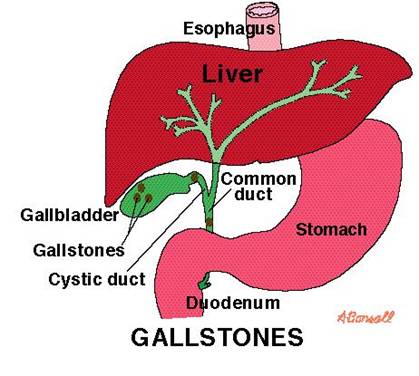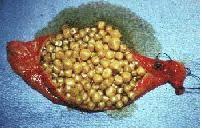
Heal Yourself at Home - 4 steps to health
(2) Clean the body's cleaning organs:
Bile can crystallize in the gallbladder forming gallstones from bile components. The reason is not clearly understood

~80% of people with gallstones have no symptoms, but gallstones can cause extended pain (possibly more than 5 hours duration), nausea and/or inflammation. Other symptoms can include vomiting, dark urine and pale stools. Possible complications include:
• Gallbladder attack (biliary cholic) - caused by a gallstone blocking the bile duct; a crampy pain is felt in the right upper part of the abdomen; blocking bile flow interferes with efficient fat metabolism and absorption of the fat soluble, antioxidant vitamins A, D, E and K;
• Gallbladder infection (cholecystitis) - with inherent severe pain and fever;
• Inflammation of the pancreas (pancreatitis)
• Bile duct infection (cholangitis)
• Jaundice - yellowish skin is a symptom

Cleansing the gallbladder of small gallstones and the liver of any small intra-hepatic stones (formed inside intrahepatic bile ducts) dramatically improves digestion (obviously necessary for health). Some stones are just too large to be flushed out, and although the liver/gallbladder flush is unable to remove large stones, many attest to the ability of the liver flush to address many symptoms associated with large gallstones (E.g. gallbladder attack) and also to give an increased sense of well being.
As intra-hepatic stones grow and become more numerous the back pressure on the liver causes it to make less bile, and as your gallbladder fills with stones, less bile makes it more difficult for the gallbladder to remove the stones. By way of analogy, if your garden hose had marbles in it much less water would flow, which in turn would decrease the ability of the hose to squirt out the marbles. Consequentially, less cholesterol leaves the body and cholesterol levels rise, thus creating more gallstones.
Gallstones, being porous, can pick up bacteria, cysts, viruses and parasites that are passing through the liver. In this way "nests" of infection are formed, supplying the body with fresh bacteria. Permanently curing a stomach infection (such as ulcers or intestinal bloating) is less likely without removing intra-hepatic stones from the liver.
Overnight Liver / Gallbladder Cleanse
Of the 500,000-700,000 gallbladders removed each year inthe U.S., only a few thousand need to be removed - according to natural alternative doctor Joseph Mercola, M.D.,and then usually because the warning signs were ignored.
Anyone who has had their gallbladder removed will need to take some form of bile salts with every meal for the rest of their life (to prevent a large percentage of the good fats they eat from being flushed down the toilet). If one does not have enough fats in the diet, their entire physiology will be disrupted - especially the ability to make hormones and prostaglandins.
(Dr. Mercola recommends Beta Plus from Biotics Research);